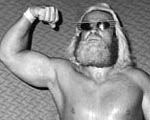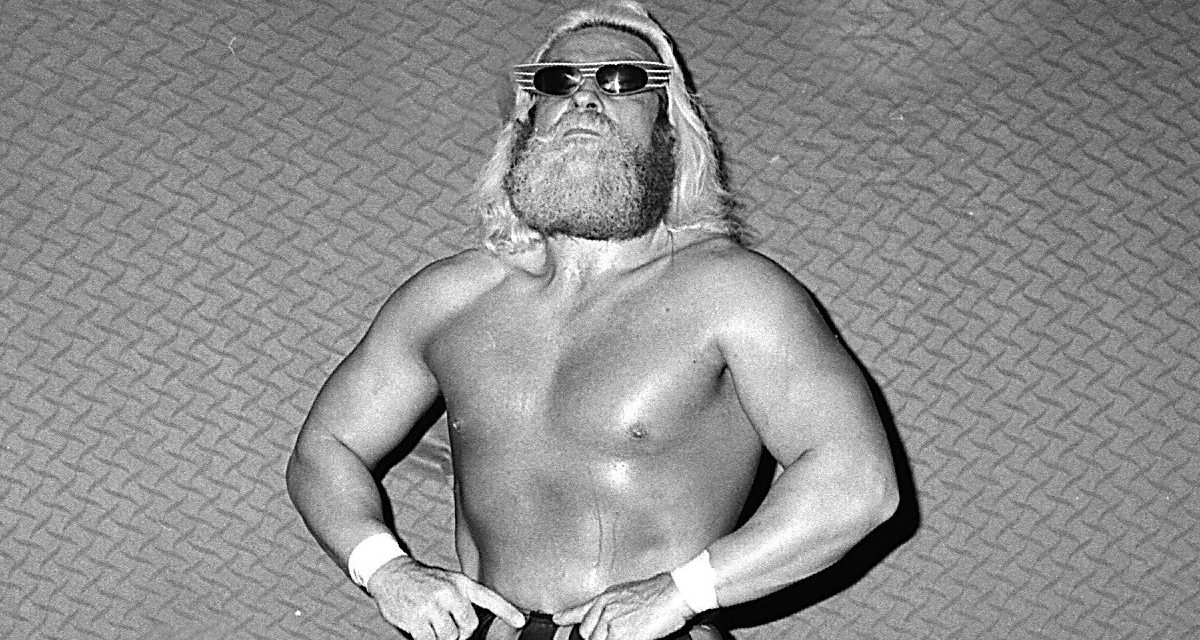Dave Sherwin was Goldie Rogers right from the start, at least style wise. “No Class” Bobby Bass first met him at Toronto’s Sully’s Gym, where they both trained as wrestlers, and can vividly remember the wild outfit Sherwin wore.
“I’ll never forget, when he walked in, he had purple pants on, white belt with a white shirt with red things all over it, and white cowboy boots,” recalled Bass (Dennis Baldock). “The character would develop with him. As far as I know, he was the first Macho Man, then Randy [Savage] came along. He called himself Macho Man Goldie Rogers.”
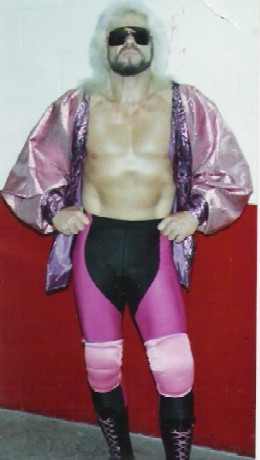
Goldie Rogers at the Berwick Arena in Nova Scotia in 1991. Photo by Mary Bond
Preening about the ring — “arrogant, with my nose always up in the air” — dressed in shiny pinks and purples, with honkin’ huge sunglasses, hair (and occasionally a beard) dyed white, he cut quite the figure.
It was fun to play his gimmick up, said Rogers.
“You just have to live it, you’ve got to live who you are,” he told SLAM! Wrestling. “I was the same inside and outside the ring.”
He’s careful to stress that he wasn’t effeminate, but rather “gorgeous but rough, just like Buddy Rogers. Gorgeous George was always a little bit on the soft side to me, but Buddy Rogers was strong and tough. I made my gimmick basically after Buddy Rogers.”
His voice, low and growly, scratching out of his throat, was never girlie. It’s still the same today. “I think I started it when I started wrestling and became a heel, doing interviews. I didn’t want to sound like the rest of the guys. I did it so much it became a habit, I guess.”
Born in Cobourg, Ontario in 1950, Sherwin was a fan of professional wrestling as a child.
“My dad used to take me to matches and stuff like that. I just got interested in wrestling, and one day decided I was going to be a professional wrestler. I was just leaving high school, and I sat down and had a serious talk with myself. I said, ‘What do you think you’re going to be for the rest of your life?’ I thought, ‘I’d really like to be a professional wrestler.’ I did a story on professional wrestling in high school. … I went to Toronto and trained in Toronto, and the rest was history.”
Well, not so fast.
It wasn’t easy back in the day to find a trainer.
Sherwin tried the direct approach with The Sheik (Eddie Farhat), but perhaps in too public a location.
“[The Sheik] was at Maple Leaf Gardens and I was going there for the longest time, trying to find somebody to train me. One night, he was in the ring. Me being stupid, I thought I could jump in the ring, and maybe he would work with me, because I didn’t know what to do … the cops pulled me down off the railing, and I was lucky they did because I found out later about his blades that he had on his knuckles. He used to slice people with his blades if anybody attacked him, just ‘whooosh’ and he would just rip the guy to pieces.”
Years later, he met The Sheik in Cobourg and he told him the story. “He said, ‘Now that you know what you know now, would you have done it again?’ I said, ‘I sure would have.’ I was trying to get into wrestling any way I could.” The only way to get noticed was to make an impression on somebody.
But Sherwin didn’t impress the Toronto wrestling honchos, promoter Frank Tunney and announcer Norm Kimber either. “I walked into Maple Leaf Gardens and said that I wanted to be a professional wrestler, and they both started laughing at me. They told me where Phil Watson’s training school was. So I went to him and started training with him.”
Things moved quickly from there.
“I went there in April 1972 and I think I was wrestling by June. I had the quick course,” said Rogers. The training took place at Sully’s Gym, above the auto body shop at Queen and Ossington, in Toronto. (Watson having found a home for his school after training his first students outside in High Park.)
The future Goldie Rogers was a natural; “The very first night I got in line to take a bump, they asked me first if I could take a bump; I said, ‘Yeah, sure.’ Then I just went right in there and did it. They were doing backdrops, and I took a backdrop and never had no problem. I never got trained on how to take a bump properly, I just learned on my own.”
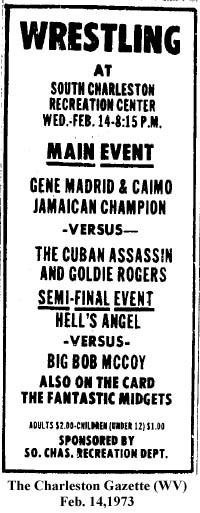
Fellow trainee Dennis Baldock — the future Bobby Bass — confirmed Sherwin’s skills. “We both were quick learners. Like I told Phil, it’s funny, the only guys who came out of your school to make any name for themselves was me and Goldie.”
When quizzed about training Rogers, Watson chuckled at the memory. “He used to love the fries with gravy and poutine. He could pack the food away.”
Sherwin started in southern Ontario on small shows, and then worked for Larry Kasaboski in Northern Ontario. He can’t remember all the masks and gimmicks that first year; he did whatever he was asked. There were Masked Assassins, Masked Medics …
“First year, I was Joe Schmo, every time I was Joe Schmo the first year. But when I became Goldie Rogers, I was Goldie Rogers for my whole career,” he said.
Ah yes, the name change.
“I was wrestling up here with a guy called The Mighty Humphrey. Beard, he sang, did country and western stuff. We were headed down to West Virginia and on the way down, he made up the name Goldie Dove. I just hated that,” Rogers recalled. They got to the territory, and the promoter, Gypsy Joe didn’t like Goldie Dove either, and changed it to Goldie Rogers, the son of Buddy Rogers.
Then the rib began.
Gypsy Joe told Sherwin that Buddy Rogers lived just a few miles away from where they were wrestling that night.
“He’s probably going to send some of his guys down to check you out, because they announced you as the son of Buddy Rogers,” said Gypsy Joe.
“I was in the dressing room getting dressed and somebody yelled out, ‘Hey, those guys from Buddy Rogers are down.’ There were about four or five guys that came in, in suits. They closed the curtain and I went to move to another dressing room by myself. I thought they were there to beat me up. I was just a young kid, didn’t know what was going on, scared like crazy. I don’t know what happened. I think they were just guys who walked in.”
Once he got past the initial fear, Sherwin really began rolling with the Goldie Rogers character. But the folks back home didn’t understand.
“I said I was from Hollywood, and all the people back here when I came home said, ‘Are you ashamed of being from Cobourg?’ I said, ‘If I said I was from Cobourg, nobody would know where it was. They couldn’t relate to it. Everybody could relate to Hollywood, California.'”
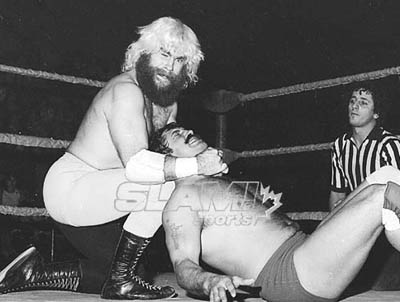
Don Kolov is the victim, as Goldie Rogers stretches his neck with a chinlock and a knee in the back. Photo by Bob Leonard
Goldie Rogers is probably best known for his time in Calgary for Stampede Wrestling and out in the Canadian Maritimes, though he worked countless places, including Montreal, Vancouver, Charlotte, and Kansas City.
“I mostly felt at home in Calgary and down east too,” he agreed. “And in Maple Leaf Gardens, I was welcome there for a long time.”
Among his favourites to work with were Bret Hart, and the Cormiers: Leo Burke, Rudy Kay, The Beast, and Bobby Kay.
“All the Cormiers, they all had bad vision, and were known for potatoes … very bad for potatoes because they had bad eyesight,” he explained. “Especially The Beast. You’d always get hurt working with him. We had a chain match in Halifax, Nova Scotia, 45 minutes, we went Broadway, time-limit draw. I made the mistake of letting the referee unhook the chain from my wrist first. We made it through the 45 minutes, and I never got hurt. I thought, ‘Fantastic, I made it through a match without getting hurt with this guy, because he’s dangerous.’ Just clumsy, dangerous. Anyway, he wrapped up the chain around his fist, bang with the chain, split my head open with the chain, the blood was all over the place. It was after the 45 minutes. I should have gotten smart and just left the ring, but I stayed around doing my strut thing, and that’s when he brought the chain up, busted my head open with it, split my head wide open.”
It wasn’t unusual for Rogers to instigate something with the fans. In particular, he remembers a bout in Summerside, Prince Edward Island, teaming with “Dr. D” David Shults against Leo Burke and a partner.
“We’re out in the ring and there’s some schmozz going on. Leo Burke put the sleeper on me, and I just barely got out of it. I was hanging over the ropes, selling the sleeper. Some guy came up from the front row and grabbed my hair and started tying it in knots to the ropes. So I reached out and grabbed him like this and I pulled him by the ears. I was going to give it to him. Shults was standing over top of me, and they were throwing chairs into the ring, everything. He swung at this guy. He hit the guy two times, and the third time, he slipped out of my hands and the chair came and whacked me right in the head. I had a big scrape mark down the front of my face. We got back to the dressing room and I said, ‘What did you hit me for? I had the guy. I didn’t need no help.’ He said, ‘I thought you were in trouble.’ I ended up getting a sore face out of the deal.”
The prison shows for Stampede Wrestling were another story. “I wrestled Mr. Hito in Drumheller prison. When you go into prison, it’s the exact opposite from what it was out in the real world. Bad guys were cheered by the prisoners, and all the good guys, they were booing them. I was wrestling Mr. Hito and he threw me out onto the floor. I was out on the floor, selling the whole bit. All of a sudden, I got lifted right off the ground. It was this great, big, huge black guy; he must have been 6’9″, about 320 pounds. He lifted me off the floor and said, ‘Go in there and kill that C.S.’ I said okay. He picked me up just like a wrestler, threw me over the top rope. I landed in the ring and started beating Hito up — and threw him out on the floor, because I didn’t want to face this guy if I didn’t do it. I told him, ‘You need to sell for me for a little bit.’ I beat him up and threw him out onto the floor, and they all started cheering and everything.”
Pro wrestling was his life. “At the time, it was a wonderful way of life. You got to travel all over the world, see different places — but a lot of the time, you just see them from a car window as you’re driving by. … eventually I just got tired of looking out of the window, because I’d see the scenery so many times before. But I got to go all through the States, all through Canada, and had a really good time.”
He was even booked for a tour of Japan, arranged by The Dynamite Kid, but turned it down to work in the Maritimes. He never got the call again. “You always look in hindsight. I realized later I should have gone to Japan instead of going down to New Brunswick. Things happen, you make choices; sometimes they’re right, sometimes they’re wrong. But you always learn from your experiences.”
Rogers was a key figure in Stampede Wrestling with some future Japanese stars, however, including Keichi Yamada (Jushin “Thunder” Lyger) and Hiro Hase. His smaller stature made him a great foil for their high-flying style.
Many remember Rogers from his time as enhancement talent in the WWF, particularly for the TV tapings down in Brantford, Ontario. But his connection to the Tunneys in Toronto predates the WWF. Rogers was a regular for the Toronto shows run out of Jim Crockett’s Charlotte promotions too.
It was a weird time, he said, of the switch from Crockett to the WWF. “I was there during the transition, when they left … Everything was going along just like normal, and all of a sudden they were gone and WWF was in.”
“All the time when I would come home, Jack Tunney would tell me, ‘Phone me when you get in to town.’ He used to always call me up for his Sunday nights. … I’d just be backup, and he’d pay me $500 for coming up as backup. … Just to make sure everybody showed up. … One time I had to go pick up Sgt. Slaughter at the airport, his plane was late. Jack threw me his keys to his brand-new Caddy. He said, ‘Go pick up Sgt. Slaughter.’ He gave me the flight number and everything. So I picked him up, and when I got back, he said, ‘You’re done for the night. You can go home.’ Most of the time, I never worked but got paid for it. I used to do TVs in Hamilton, CHCH. I used to drive the van and pick up the guys at the airport. We’d go down and do TV and I’d take them back to the hotel, get paid for TV and all the odd jobs.”
As a colourful jobber against the even more colourful WWF stars, Rogers stood out. But he wishes he hadn’t.
“One of the biggest mistakes I ever made was when I wrestled for WWF, I should have worn a mask, protected my gimmick. Because after I started going to other promotions after doing jobs for WWF, they all knew me, and they all had me doing jobs,” he lamented.
The money was good, though, sometimes a grand a night for WWF shows he was flown to on Tunney’s behalf in Calgary, Edmonton or Regina.
He made a lot of friends along the way, including the biggest of them all, Andre the Giant, who he first met in Vancouver when Rogers was teaming with his old training partner, Bobby Bass. Andre used to call Goldie “Charlie” because he thought he looked like Charles Manson. When Rogers got to the WWF dressing room, he went to shake Hulk Hogan’s hand; but the Hulkster was less than friendly. However, when Andre said hi and Hogan recognized that Goldie was a friend, he changed his tune quickly.
Besides teaming with Bass, they fought on numerous occasions as well.
“I worked with Goldie many times. Me heel, him babyface. Had hell of a matches with him. For someone small in stature, that son of a bitch can go, let me tell you,” said Bass. “Instead of going in and beating him down to nothing, you say, ‘Goldie, I’m going over, but what do you want to do?’ You’d go, ‘Here’s the finish’ and call the rest of it in the ring. In the end, you make him look good, he makes you look good. Then we go home to the finish. If I was going to go over, I’d give him, maybe, 75% of the match. Then you have a great time with it.”
A falling out with Jack Tunney — Rogers opted to work a Dave “Bearman” McKigney outlaw show in his hometown of Cobourg, which upset the WWF “President” — meant Rogers lost a sizable income.
He retired in 1992, with his last match in the Maritimes.
“I was scheduled to go back in ’93, but I called up and cancelled because I took over the cab business here in Cobourg,” he explained. Rogers had been in the cab business during the winters in Cobourg while he was home helping elderly parents.
Eventually, the taxi business was too demanding. “I had to work a lot of hours. I was working, like, 20 hours a day. I just was working really hard and decided to give up wrestling. Of course, I’d been wrestling 20 years then. That’s an average career. … 20 years is a good career, any longer than that is too long.”
It was a decent cycle for a while, stay home, drive a cab, stop working out, and then come spring, whip himself back into shape again.
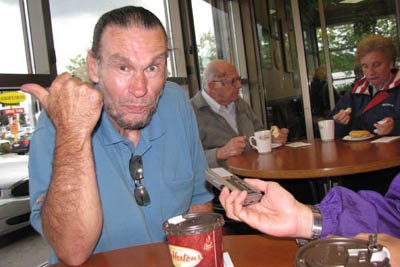
Goldie Rogers answers some questions in the fall of 2009. Photo by Greg Oliver.
Now on long-term disability, Rogers is a well-known character around town. Married just once, with one biological son that he hasn’t seen since he was one year old, Rogers lives alone with his dogs.
In 2003, he had open-heart surgery in Kingston — five bypasses; “Just five, nothing serious,” he chuckled.
In 2005, he found God, which led to his current work for the Salvation Army. “I wrestle for God now,” he said.
“I ended up with an enlarged heart after the operation, and I don’t think the heart returns to normal size after it’s been damaged,” Rogers said. “After about a year, they were doing more X-rays, looking for more damage, checking my shoulders and knees, seeing if I needed any more repair work done. They X-rayed my whole body. When I got back to the doctor’s office, he gave me the wonderful news. ‘Your heart’s gone back to normal size.’ That’s when I said, ‘Praise the Lord.’ That’s when he blew up on me. ‘What about all us doctors that did all that work on you?’ I said, ‘I’m thanking him first, because I know he was the one responsible for that.”
RELATED LINKS
- July 29, 2012: Guest column: Goldie Rogers – One in a million, Jack!
- July 24, 2012: Listen up, Jack! Friends tell Goldie Rogers stories
- July 23, 2012: Goldie Rogers, dead at 61, was Cobourg through and through
- June 13, 2006: Hometown honours Goldie Rogers
